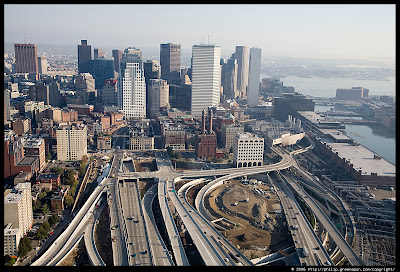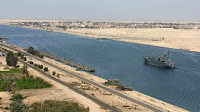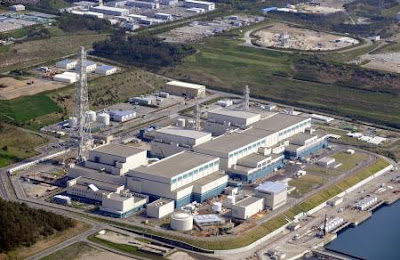source: wikipedia
FALKIRK WHEEL (SCOTLAND)
The Falkirk Wheel is a rotating boat lift in Scotland. It connects the Forth and Clyde Canal with the Union Canal. Named after the nearby town of Falkirk in central Scotland, the lift opened in 2002. The two canals it serves were previously connected by a series of 11 locks, but by the 1930s these had fallen into disuse. The locks were filled in and the land built upon.
The plan to regenerate central Scotland's canals and reconnect Glasgow withEdinburgh was led by British Waterways with support and funding from seven local authorities, the Scottish Enterprise Network, the European Regional Development Fund, and the Millennium Commission. Planners decided early on to create a dramatic 21st-century landmark structure to reconnect the canals, instead of simply recreating the historic lock flight. Designs were submitted for a boat lift to link the canals; the Falkirk Wheel design won. As with many Millennium Commission projects the site includes a visitors' centre containing a shop, café, and exhibition centre.
The difference in height at the wheel is 24 metres (79 ft), roughly equivalent to the height of an eight-storey building. The Union Canal is still 11 m higher than the aqueduct which meets the wheel, and boats must pass through a pair of locks to descend from this canal onto the aqueduct at the top of the wheel.
The structure is near the Rough Castle Fort; the closest village is Tamfourhill. On 24 May 2002, Queen Elizabeth II opened the Falkirk Wheel as part of her Golden Jubileecelebrations. The opening was delayed a month due to flooding caused by vandals who forced open the wheel's gates.
Design
The main project architect was Tony Kettle who was, at the time, Design Principal of Edinburgh based RMJM. Kettle worked out the concept of keeping two arms upright while rotating, by building a model using his daughter’s Lego toy construction set. This model was displayed in the V&A British Design Exhibition in 2012. Initial designs by Nicoll Russell Studios and engineers Binnie Black & Veatch.
Bachy/Soletanche and Morrison Construction Joint Venture won the contract to design the wheel and receiving basin, a new section of canal, a tunnel beneath the Antonine wall and a section of aqueduct. In turn the Joint Venture appointed Butterley Engineering to design and construct the wheel. Butterley undertook all construction work for the wheel and set up its own team to carry out the design work. This team comprised Tony Gee and Partners, to undertake the structural design responsibilities and M G Bennett & Associates to design the mechanical and electrical equipment for the wheel.
The wheel has an overall diameter of 35 metres (115 ft) and consists of two opposing arms which extend 15 metres beyond the central axle and take the shape of a Celtic-inspired, double-headed axe. Two sets of these axe-shaped arms are attached about 35 metres (115 ft) apart to a 3.5 metres (11 ft) diameter axle. Two diametrically opposed water-filled caissons, each with a capacity of 80,000 imperial gallons (360,000 l; 96,000 US gal), are fitted between the ends of the arms.
These caissons (also known as gondolas) always weigh the same whether they are just full of water or are carrying their combined capacity of 600 tonnes (590 long tons; 660 short tons) of floating canal barges as, according to Archimedes' principle, floating objects displace their own weight in water, so when the boat enters, the amount of water leaving the caisson weighs exactly the same as the boat. This keeps the wheel balanced. Despite its enormous mass, it rotates through 180° in five-and-a-half minutes using very little power. It takes just 22.5 kilowatts (30.2 hp) to power the electric motors, which consume just 1.5 kilowatt-hours (5.4 MJ) of energy in four minutes, roughly the same as boiling eight kettles of water.
The wheel is the only rotating boat lift of its kind in the world. The United Kingdom has one other boat lift: the Anderton boat lift inCheshire. The Falkirk Wheel is an improvement on the Anderton boat lift and makes use of the same original principle: two balanced tanks, one going up and the other going down.
Since 2007 the Falkirk Wheel has featured on the obverse of the new series of £50 notes issued by the Bank of Scotland. The series of notes commemorates Scottish engineering achievements with illustrations of bridges in Scotland such as the Glenfinnan Viaduct and the Forth Rail Bridge.
FALKIRK WHEEL IN MOTION
MILLAU VIADUCT (FRANCE)
The Millau Viaduct (French: le Viaduc de Millau, IPA: [vjadyk də mijo]) is a cable-stayed bridge that spans the valley of the River Tarn near Millau in southern France.
Designed by the French structural engineer Michel Virlogeux and British architectNorman Foster, it is the tallest bridge in the world with one mast's summit at 343.0 metres (1,125 ft) above the base of the structure. It is the 12th highest bridge deck in the world, being 270 metres (890 ft) between the road deck and the ground below.Millau Viaduct is part of the A75-A71 autoroute axis from Paris to Montpellier. Construction cost was approximately €400 million. It was formally inaugurated on 14 December 2004, and opened to traffic on 16 December. The bridge has been consistently ranked as one of the great engineering achievements of all time.
THE MOSE PROJECT (LARGEST FLOOD PREVENTION PROJECT)
Venice is under serious threat due to the rise in sea level and sinking of land at an alarming rate. The MOSE project will protect the Venetian Lagoon from being submerged by the Adriatic Sea and protect the famous city of Venice and the neighbouring areas from flooding. It is expected to be operational by 2014. The project will prevent flooding through the installation of 78 mobile gates at three inlets, namely Lido, Malamocco and Chioggia, which will separate the Venetian Lagoon from the Adriatic Sea.MOSE, the Italian word for Moses, is an acronym for Modulo Sperimentale Elettromeccanico, which means Experimental Electromechanical Module. The name aptly alludes to the story of Moses parting the Red Sea. Consorzio Venezia Nuova has been entrusted to carry out the project by the Venice Water Authority, with Astaldi holding a share in the project. It is a consortium of Italian construction companies, co-operatives and firms which are experienced in operating the lagoon.
The construction work on the project began in 2003 after much delay. As of June 2012, 75% of the work at the site has been completed. The project is expected to be fully completed by 2014. When completed, it will safeguard Venice and the villages located within the Venetian Lagoon from flooding, and prevent the further rise of the sea level.
Background to the Modulo Sperimentale Elettromeccanico (MOSE) project
The Great Flood of 1966, which caused massive loss of life and property, and the sinking of the city by 11 inches during the course of the last century, provided the momentum and necessity to protect Venice. The reasons for the sinking of the city of Venice are principally attributed to the rise in the sea level and extraction of ground water and methane gas within the vicinity of the Venetian Lagoon. The feasibility study for the proposals were completed in 1981 under a project named Progettone, which proposed the setting up of fixed barriers at the inlets, including mobile defence structures.MOSE took shape after being loomed over by a number of consultations and controversies. The proposal to provide a safe measure from flooding dates back to the 1970s. In 1973 a Special Law was enacted, under which six project proposals were accepted after invitations from Consiglio Nazionale delle Ricerche (CNR) and later taken up by the Ministry of Public Works in 1980. The second Special Law of Venice to provide criteria and strategies took shape under a committee known as the Comitatone, which enabled the Ministry of Public Works to grant a single concession for the companies agreed upon by private negotiation.
In 1982 Consorzio Venezia Nuova was entrusted by the Water Authority to design and implement the measures to safeguard the city, which was presented in 1989 under a project named Riequilibrio E Ambiente (REA), which translates as Rebalancing and the Environment. It provided an abstract design of the mobile barriers at the lagoon inlets and was finally approved in 1994 by the Higher Council of Public Works.
The first environmental impact study was accepted in 1998 and was improved in 2002. Construction work of MOSE finally started in 2003.
Floodgates and components of the Venetian Lagoon project
A total of 78 mobile gates are being laid at the bottom of the seabed as part of the MOSE project. They are 92ft long, 65ft wide and will weigh 300t. The mobile gates being laid at the bottom of the inlet channel are supported by 125ft long steel and concrete pilings, measuring 500mm in diameter and 20m in length, driven into the lagoon bed.
The floodgates consist of a metal box structure. Compressed air is pumped into the structure when a tide of more than 110m height is expected. The air will rise up the barriers to the surface of the water to block the flow of the tide and prevent water from flowing into the lagoon.
Floodgates are hollowed at the bottom, to allow the blowing of compressed air. They will be filled with water and lowered into the seabed when there is no harm of flooding. The floodgates at each inlet will function independently depending on the force of the tide expected.
The MOSE project also includes strengthening of the coastal areas, raising the quaysides and paving of the city.
Contractors involved with Venice's MOSE scheme
In.Te.Se costruzioni d'acciaio designed and constructed two hydraulically self-propelled loading carriages for the project. The loading carriages are being used in moving and positioning the reinforcing piles vertically.
The batching plants used for construction in the MOSE Project are supplied by SIMEN.
source: water technology
THE MOSE PROJECT
source: youtube.com
THE MAERSK TRIPPLE E ( THE LARGEST VESSEL)
The Maersk Triple E class is a family of large, fuel-efficient container ships, designed as a successor to the Mærsk E-class. In February and June 2011, Maersk awarded Daewoo Shipbuilding two US$1.9 billion contracts ($3.8bn total) to build twenty of the ships.
The name "Triple E" is derived from the class's three design principles: "Economy of scale, Energy efficient and Environmentally improved". These ships are expected to be not only the world's largest ships in service, but also the most efficient containerships per twenty-foot equivalent unit (TEU) of cargo.
The ships will be 400 metres (1,312 ft) long and 59 metres (194 ft) wide. While only 3 metres (9.8 ft) longer and 4 metres (13 ft) wider than E-class ships, the Triple E ships will be able to carry 2,500 more containers. With a draft of 14.5 metres (48 ft), they will be too deep to use any port in the Americas or cross the Panama Canal, but will be able to transit the Suez Canal when sailing between Europe and Asia. At 400 m, the vessels are only 2 m short of a quarter-mile in length.
One of the class's main design features are the dual 32 megawatts (43,000 hp) ultra-long stroke two-stroke diesel engines, driving two propellers at a design speed of 19 knots (35 km/h; 22 mph). Slower than its predecessors, this class uses a strategy known as slow steaming, which is expected to lower fuel consumption by 37% and carbon dioxide emissions per container by 50%. The Triple E design helped Maersk win a "Sustainable Ship Operator of the Year" award in July 2011.
Maersk plans to use the ships to service routes between Europe and Asia, projecting that Chinese exports will continue to grow. The Europe-Asia trade represents the company's largest market; it already has 100 ships serving this route. Maersk hopes to consolidate its share of the Europe-Asia trade with the addition of the Triple-E class ships.
Design
Unlike conventional single-engined container ships, the new class of ships is expected to be a twin-skeg design: It has twin diesel engines, each driving a separate propeller. Usually a single engine is more efficient, but using two propellers allows a better distribution of pressure, increasing propeller efficiency more than the disadvantage of using two engines.
The engines have waste heat recovery (WHR) systems; these are also used in 20 other Mærsk vessels including the eight E-class ships. The name "Triple E class" highlights three design principles: "Economy of scale, energy efficient and environmentally improved".
The twin-skeg principle also means that the engines can be lower and further back, allowing more room for cargo. Maersk requires ultra-long stroke two-stroke enginesrunning at 80 rpm (versus 90 rpm in the E class); but this requires more propeller area for the same effect, and such a combination is only possible with two propellers due to the shallow water depth of the desired route.
A slower speed of 19 knots is targeted as the optimum, compared to the 23–26 knots of similar ships. The top speed would be 25 knots, but steaming at 20 knots would reduce fuel consumption by 37%, and at 17.5 knots fuel consumption would be halved.[20] These slower speeds would add 2–6 days to journey times.
The various environmental features are expected to cost $30 million per ship, of which the WHR is to cost $10 million. Carbon dioxideemissions, per container, are expected to be 50% lower than emissions by typical ships on the Asia-Europe route and 20% lower than Emma Maersk. These will be the most efficient containerships in the world, per TEU.
FLOATING FOR THE FIRST TIME














